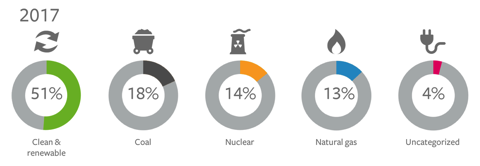Facebook is the latest among a growing number of companies accelerating their transitions to clean energy renewables, pledging earlier this week to achieve 100 percent renewable energy by the end of 2020. In fact, they have doubled down on their previous efforts: As part of the RE100, the company had originally pledged to reach a goal of 50 percent by 2018, but they reached that benchmark a year early.
Facebook’s renewable usage last year
Achieving that milestone in just two years is incredibly ambitious, but if anyone can do it, Facebook seems like a good possibility. As we all know, Facebook has an enormous economic and cultural impact, so their pledge will boost the public’s support for clean energy immeasurably.
Facebook has also pledged to reduce its greenhouse gas emissions 75 percent over the same timeframe.
When we think of carbon emissions, we think of automobiles and factories, but actually computing uses up a lot of energy these days. Believe it or not, computers in our country alone are responsible for the unnecessary production of millions of tons of greenhouse gases annually. That doesn’t even account for the Internet, which essentially relies on countless server farms that use enormous amounts of energy.
In the latter case, Facebook has already been working to offset the impact of its own servers. The company carefully considers access to cost-effective renewable energy when siting its new data center locations. Facebook is making leaps and bounds by completely rethinking and reengineering everything from servers to cooling systems with regards to energy efficiency, seeking solutions that use far less energy and water than similar facilities in the industry.
Like other tech companies, Facebook is also being both energy-efficient and cost-efficient by producing its own energy, which is often on the same grid as its data centers, and making long-term commitments to clean energy providers. In just the past 12 months, the company has signed contracts for over 2,500 megawatts.
Individual users have a role to play, as well, because much of our tech energy is wasted when we leave our computers on rather than shutting them down, or leave our cell phone chargers plugged into the wall when they aren’t in use.
There are options to make saving on tech energy easier. The EPA’s EnergyStar program has many solutions, including free Computer Power Management (CPM) software that automatically place computers into a low-power “sleep mode” after a period of inactivity. Conservative small-business owners should check out EnergyStar’s “Business Case for Power Management” to find out how they can save money by saving energy.
CRES congratulates Facebook on surpassing their renewable energy goals and reaching for new ones. It’s great to see increasing private-sector commitments like this, especially in Silicon Valley. Check out other businesses and tech companies doing great things for clean energy like Google and Apple.

